Williams Acceptance Rate: Class of 2029 5:09 AM (6 hours ago)
Williams College, often ranked as the #1 Liberal Arts College in the nation, is a small liberal arts college located in Williamstown, Massachusetts. Established in 1793, Williams has an enrollment of 2,061 undergraduate students and is considered one of the “Little Ivies.” Williams’ early acceptance rate rose this year to 26.6% for the Class of 2029 — and the college’s overall acceptance rate followed a similar trend.
WILLIAMS ACCEPTANCE RATE
After admitting a record low 7.52% of students to the Class of 2028, Williams’ overall acceptance rate for the Class of 2029 was 8.5%, according to the Williams Record.
18 of the 1,038 students admitted through Regular Decision had previously been deferred during the early decision round. Meanwhile, 2,194 applicants, or 15.4%, were waitlisted.
Williams’ “target class size” is 560 students this year, up from 550 in recent years, after a new effort to increase first-year housing on-campus.
TTA TOP TIP: Williams College remains one of the most competitive liberal arts colleges in the country. To stand out in such a selective pool, applicants should focus on two key areas: academic excellence and distinctive extracurricular impact. Williams places a strong emphasis on intellectual curiosity, so demonstrating a passion for learning — through rigorous coursework, research, or independent projects — can be a game-changer. Additionally, leadership in meaningful extracurriculars, rather than participation in many activities, signals depth and dedication.
At Top Tier Admissions, we are committed to making the college admissions process more transparent. Easy access to clear data helps families understand trends in college admissions to make more informed decisions. This year we’re once again collecting acceptance rate data at selective schools and providing insight and analysis of our own.
WANT TO READ MORE?
Are you thinking about applying to Williams? Curious about admissions trends and strategies to improve your odds? Contact us to discuss our Application Boot Camp® or Private Counseling program— we look forward to supporting you!
- Williams College Acceptance Rate: Early Trends
- The Value of Attending a Liberal Arts College
- What Are the Little Ivies?
- Liberal Arts College Acceptance Rates: Increase Your Odds
- Average GPA and Class Rank at Top Colleges
- Average SAT Scores at Top Colleges
If you enjoyed this post, follow us on Instagram @toptieradmissions for more tips and subscribe to our blog for expert insights & college admissions news!
The post Williams Acceptance Rate: Class of 2029 appeared first on Top Tier Admissions.
Law School Applications Are Surging 1 Apr 10:17 AM (3 days ago)
Law school applications to nearly 200 law schools nationwide are up 20.5% compared with last year, as the Wall Street Journal reported this month.
Each year the American Bar Association releases information on the most recent batch of law students in the U.S. In 2024, the incoming class was ~39,600 students, 4.8% larger than the incoming class of 2023.
And yet, 2025 is about to blow those numbers out of the water.
Grad School Analysis & Guidance
Craft your graduate school strategy and sharpen your applications and essays.
LAW SCHOOL APPLICATIONS ARE BOOMING
This week, Axios.com reported that Georgetown University Law has already received over 14,000 law school applications this year. They’re up 25% from last year and it is the highest number of law school applicants any law school in the country has ever received. Last year, they received 11,296 applications.
LSAC, the Law School Admissions Council, is taking note. They dropped the ever-so-frustrating Logic Games section, and added more June LSAT test dates. Monitoring high demand for the LSAT, they added a fourth day for June 2024 testing —afterall, somebody has to get all of these added law school applicants in for their $238 LSAT exam.
Interestingly enough, women made up 56% of the entering J.D. classes of 2024. Women may hit close to 60% in 2025. There is a clear gender gap in law school admissions, just as with college admissions now.
LAW SCHOOL: IT’S NOT TOO LATE
But, why so many applicants? Why the boost? The Wall Street Journal cites “A weakening white-collar job market and a contentious political climate.” In other words, as today’s college students and working professionals are watching politics unfold and witnessing their friends try to enter a deteriorating job market, they’re coming for law school in droves.
Grad School Essay Guidance
Graduate school programs value applications with strong writing, compelling ideas, and a clear sense of self.
Want to join them? It is not too late to submit law school applications for a fall 2025 start!
TOP LAW SCHOOLS STILL ACCEPTING APPLICATIONS FOR THIS FALL
| University | Final Application Deadline |
| Baylor University School of Law | July 18 |
| Cornell University Law School | July 1 |
| Elon University School of Law | July 15 |
| George Mason University Scalia School of Law | April 30 |
| Georgia State University School of Law | June 1 |
| Gonzaga University School of Law | April 15 |
| Hofstra University Deane School of Law | April 15 |
| Indiana University Bloomington School of Law | June 1 |
| Michigan State University College of Law | August 1 |
| Ohio State University Moritz College of Law | June 1 |
| Penn State University Dickinson Law | June 30 |
| Texas A&M University School of Law | May 31 |
| UC Davis School of Law | June 1 |
| UC Irvine School of Law | May 1 |
| UC San Francisco College of the Law | April 15 |
| University of Georgia School of Law | June 1 |
| UNC Chapel Hill School of Law | May 1 |
| University of Minnesota Law School | June 1 |
| University of San Diego School of Law | June 1 |
| University of Wyoming College of Law | April 30 |
| USC Gould School of Law | May 1 |
| Villanova University Widger School of Law | July 1 |
| Washington & Lee University School of Law | July 1 |
| WashU St. Louis School of Law | August 10 |
| William & Mary Law School | August 1 |
LET’S TALK STRATEGY
Unsure how to navigate this ultra-competitive cycle? Contact us for expert law school admissions guidance.
P.S. If you’re considering business school instead, you’re not alone—MBA applications are also on the rise. Let’s craft an application that gets noticed.
The post Law School Applications Are Surging appeared first on Top Tier Admissions.
How Long Should You Wait on the Waitlist? 31 Mar 11:04 AM (4 days ago)
Applying to college, students hope to be accepted and fear being rejected. In the regular round, the waitlist is typically not even on their radar. And yet, thousands of students receive this purgatory-like decision in March: neither in, nor out of the class. Once you receive a waitlist notification, what should you do, and how long should you hold out hope of being admitted?
WAITLIST: TWO IMMEDIATE STEPS TO TAKE
First, accept an offer of admission at another college or university and make your enrollment deposit. Do not wait to get off of a waitlist! This is a time when you need to have a plan A and a plan B (and sometimes a plan C!). If possible, attend an admitted students’ day program at the school where you have enrolled because this is your plan A, and you will likely be moving in at the end of summer.
Second, if you have any interest in remaining on a waitlist and keeping a plan B alive, accept and confirm your spot on the active waitlist. Schools waitlist far more students than seems reasonable, and the more selective the school, the less likely they are to admit more than a handful of students. But, to have any chance of admission, follow the instructions sent with your waitlist offer: if updates are welcome, submit an update. If you are asked to submit a final transcript, submit a final transcript. Only students who take the affirmative step of accepting their waitlist offer will be considered for admission. For example, for the Class of 2027, American University placed 7,312 (41%) of the 17,786 applicants for first-year admission on their waitlist. Only 18.7% of those students chose to remain on the waitlist, and, ultimately, 491 (35.9%) of them were admitted.
EMBRACE UNCERTAINTY
“The test of a first-rate intelligence,” F. Scott Fitzgerald said, “is the ability to hold two opposed ideas in mind at the same time and still retain the ability to function.” Hanging on to a waitlist spot while enrolling elsewhere means embracing uncertainty, holding two possible outcomes in mind and being okay with that tension. To reduce the discomfort of this position, train your mind back to plan A after you maximize your chances of getting off a waitlist.
College Essay Guidance
Experience personalized, expert guidance to elevate your college essays and secure your spot at top universities.
Some schools have response forms with strict word limits; others allow submission of supplemental materials; while still others advise against any updates or submissions at all after confirming your spot. If a Letter of Continued Interest (LOCI) is allowed, do spend time and effort on making your case for why you are a great fit at that particular school (Show, don’t tell!)—don’t send a passionate email five minutes after receiving your waitlist offer. Send an additional academic recommendation if allowed, and be sure to submit your most recent grades and provide an email address that will be current over the summer. Remember: they have read your application. Only new information—like awards, projects, publications, test scores, or grades—will have any impact. Think carefully about any new projects or initiatives you have embarked on. If you are short on new actions, seize the day and send a letter to the editor of your local newspaper or meet with administrators at your school to act on an issue you care about—then report on this to your dream school in your update. Submit your waitlist update early in the summer: some schools strike quickly to hit their enrollment target in May, while others continue to fill spots into July, as students play musical chairs once they are admitted off waitlists and essentially “un-enroll” at school A and deposit at school B. If you haven’t heard anything by mid-June, reach out to admissions for an update, reiterating your continued interest.
WAITLIST: DATA SPEAKS
To assume some control in this process, you can always turn to data. Schools admit, on average, 20% of students who remain on waitlists, but selective schools (those admitting less than half of applicants) admit an average of 7% of students on their active waitlists. The range is vast. For the Class of 2027, Michigan State University admitted 97% of its waitlisted applicants, while Yale, Dartmouth, and Caltech are in the Zero Percent Club: they admitted no students off of their waitlists. While these percentages change from year-to-year, knowing your odds, based on the past few years’ figures, can help you gauge how long to wait on that waitlist. Search online for the name of the school and “common data set” to access the most up-to-date admissions data, including waitlist figures, reported to the federal government. Here is a sampling:
| School | Admitted from Waitlist | Waitlist Acceptance Rate |
| UC, Santa Cruz | 10,812 | 88% |
| Stony Brook University (SUNY) | 1,577 | 88% |
| University of Washington | 2,985 | 72.4% |
| University of Wisconsin-Madison | 4,436 | 61.4% |
| Fordham University | 1,777 | 58.7% |
| Southern Methodist University | 292 | 35.6% |
| Clemson | 1,162 | 25.8% |
| Case Western Reserve | 1,141 | 14.4% |
| UC, Los Angeles | 1,400 | 11.9% |
| UNC-Chapel Hill | 36 | 0.78% |
| Williams College | 3 | 0.47% |
| Boston University | 34 | 0.38% |
WAITLIST: A TEMPORARY STATE
Whether you are admitted off of a waitlist or stick with a school that admitted you outright, this in-between state is temporary. You are going to college AND you will thrive!
If you enjoyed this post, follow us on Instagram @toptieradmissions for more tips and subscribe to our blog for expert insights & college admissions news!
The post How Long Should You Wait on the Waitlist? appeared first on Top Tier Admissions.
Tufts Acceptance Rate: Class of 2029 28 Mar 8:54 AM (7 days ago)
Tufts University is a private research university located in Medford, Massachusetts with an undergraduate enrollment of around 5,200. Students can apply to either the School of Arts and Sciences, the School of Engineering, or the School of the Museum of Fine Arts.
TUFTS ACCEPTANCE RATE
Of the 33,400 applicants, 10.5% were accepted to the Class of 2029, according to Tufts Now. Tufts is in its 5th year of a six-year test-optional pilot program. Keeping with prior years, approximately half of all applicants choose to not submit test scores to Tufts though it’s important to note that about 65% of admitted students did submit SAT or ACT scores.
55% of the admitted students attended public high schools while 11% are the first in their family to go to college. Tufts also had its largest QuestBridge applicant pool, resulting in 42 students being admitted through early decision, up from 30 last year.
International students made up 26% of the applicant pool and 11% of the admitted class.
Tufts has recently upped its recruiting efforts in rural communities. More than 50 students in the admitted class engaged with Tufts via virtual and in-person Small Town Outreach, Recruitment, and Yield (STORY) events over the past two years. Additionally, about 15% of admitted students will qualify for federal financial aid through the Pell Grant.
The School of Engineering drew a record-setting 7,600 applications while applications to the School of Arts and Sciences decreased slightly.
TTA TOP TIP: Tufts values students who are genuinely excited about learning — whether that’s through interdisciplinary interests, research, or creative problem-solving. In your application essays, highlight moments when you pursued knowledge for the sake of curiosity, engaged in thought-provoking discussions, or took initiative in exploring new ideas. Tufts’ admissions team looks for students who will contribute to the university’s dynamic academic community, so make sure your passion for learning shines through!
Consider our Research Immersion Program, which offers two specialized tracks: STEM or Business/Entrepreneurship, and dive into research excellence!
At Top Tier Admissions, we are committed to making the college admissions process more transparent. Easy access to clear data helps families understand trends in college admissions to make more informed decisions. This year we’re once again collecting acceptance rate data at selective schools and providing insight and analysis of our own.
WANT TO READ MORE?
Are you thinking about applying to Tufts? Curious about admissions trends and strategies to improve your odds? Contact us to discuss our Application Boot Camp® or Private Counseling program— we look forward to supporting you!
- Tufts University Admissions
- Tufts University: Acceptance Rates & Statistics (Class of 2028)
- Average GPA and Class Rank at Top Colleges
- How Metacognition Elevates College Applications
- Do Elite Colleges Really Hold the Key to Extraordinary Success?
If you enjoyed this post, follow us on Instagram @toptieradmissions for more tips and subscribe to our blog for expert insights & college admissions news!
The post Tufts Acceptance Rate: Class of 2029 appeared first on Top Tier Admissions.
The Value of Attending a Liberal Arts College 26 Mar 7:15 AM (9 days ago)
When it comes to choosing a college, many students (and their families) prioritize the return on investment (ROI) and career outcomes that follow a four-year degree. For years, large research universities and specialized institutions have dominated the conversation around career-focused education. However, liberal arts colleges—known for their smaller size, broad-based curriculum, and emphasis on critical thinking—offer unique and often overlooked advantages for ROI and career success.

Application Boot Camp®
Need strategic guidance from start to finish? Try Application Boot Camp®.
LIBERAL ARTS COLLEGES: WORTH IT
Here’s why liberal arts colleges are worth considering when you’re thinking about the value of your college degree.
1. Broad Skill Set for a Dynamic Job Market
In an ever-evolving job market, employers increasingly seek candidates who are adaptable, innovative, and proficient in “soft skills” like communication, problem-solving, and teamwork. Liberal arts colleges excel at fostering these skills through a well-rounded curriculum that goes beyond specialized majors. Students at liberal arts colleges often take courses in a wide variety of disciplines, allowing them to approach problems from multiple perspectives and develop versatile skills that are valuable in any industry.
Employers often value the flexibility that liberal arts students bring to the table. For instance, a student who studied psychology but also took economics and literature courses can offer unique insights into consumer behavior or communication—skills highly sought after in fields like marketing, human resources, and consulting. In fact, a recent study by the Association of American Colleges and Universities found that liberal arts graduates are more likely to advance into leadership roles in their careers due to their ability to adapt and think critically.
2. Strong Career Support and Alumni Networks
Liberal arts colleges are known for fostering tight-knit communities, which can lead to powerful networking opportunities. Alumni from these colleges often feel a strong sense of loyalty and connection, creating a supportive network for new graduates. Furthermore, smaller student populations mean that career services departments can offer personalized guidance and mentorship.
For example, alumni networks at liberal arts colleges frequently organize career panels, internships, and networking events that are accessible to students and young graduates. Students benefit from direct connections to industry leaders who can offer job referrals, mentorship, and even employment opportunities. This level of support is invaluable, especially for students launching their careers right after college.

College Private Counseling
Develop an organized and effective application strategy that leverages your academic and extracurricular experience to stand out.
3. High Acceptance Rates to Graduate and Professional Schools
For students aiming for advanced degrees in law, medicine, business, or academia, liberal arts colleges offer an excellent foundation. According to data from the National Science Foundation and other studies, liberal arts graduates often have high acceptance rates into competitive graduate programs. Admissions committees value the rigorous training in critical analysis, research, and writing that liberal arts colleges provide. Additionally, smaller class sizes enable closer relationships with professors, resulting in personalized recommendations that can strengthen graduate school applications.
Not only do liberal arts graduates excel in the application process, but they also tend to perform well in graduate programs because of their ability to think critically, write effectively, and approach problems with a broad perspective. This focus on foundational skills can lead to high-paying and fulfilling careers in fields that require advanced degrees.
In an article published by Inside Higher Ed, Katie Ferrick, senior director of workplace programs at LinkedIn said:
“…in an era when employers are basing their hiring decisions more on the skills and knowledge would-be workers have than on the degrees they’ve attained, college graduates are increasingly competing against candidates who’ve developed those abilities in other ways. If we’re hiring based on skills, that’s going to open up much more opportunity for a more equitable and diverse workplace. That doesn’t mean that there’s less value to a degree, but there are more avenues to those who earn those skills other ways, too.
In that more competitive landscape, Ferrick and others said, colleges should think in terms of “both-and”—delivering a four-year degree grounded in the liberal arts that remains the best preparation for a lifetime career, yes, but also building into their curricula more practical digital and other skills that can help graduates compete for a first job.”
Top Tier Admissions Senior Private Counselor and former Dean of Admissions at Pomona College, Dr. Tina Brooks also weighed in.
“The liberal arts are rooted in ancient Greece and Rome as a foundation for a well-rounded education but now serve as a blueprint for many US colleges and universities that ask their students to study both broadly and deeply. Practically speaking, this kind of interdisciplinary education prepares students to think creatively and address emerging issues and challenges beyond their specific major.”
4. Value-Driven Education that Cultivates Leadership
Liberal arts colleges emphasize ethical decision-making, civic responsibility, and leadership skills, preparing students to make an impact in their communities and workplaces. For students who prioritize a meaningful career with social impact, this focus can be transformative. The leadership skills developed through extracurricular involvement, class discussions, and internships often prepare liberal arts graduates for roles in non-profit organizations, public service, and socially responsible business ventures.
As companies increasingly embrace values like sustainability and social impact, graduates who are equipped to lead with a sense of purpose have an advantage. Liberal arts colleges cultivate graduates who are not only job-ready but also primed to lead and inspire change in their workplaces and communities.
5. ROI Isn’t Just About Earnings: It’s About Lifetime Satisfaction
While salary is one measure of ROI, job satisfaction and career growth are equally essential. Liberal arts colleges emphasize holistic personal and intellectual development, which translates to graduates who report high levels of job and life satisfaction. Many liberal arts alumni point to their undergraduate experiences as transformative, shaping their passions, sense of purpose, and lifelong curiosity. The career support, robust networks, and leadership skills gained at these colleges contribute to a well-rounded career experience that pays off in more than just monetary terms.
U.S. NEWS & WORLD REPORT’S TOP 25 NATIONAL LIBERAL ARTS COLLEGES: ACCEPTANCE RATES
| Rank | School | Class of 2028 Acceptance Rate |
| 1 | Williams College (MA) | 7.5% |
| 2 | Amherst College (MA) | 9.0% |
| 3 | Swarthmore College (PA) | 7.5% |
| 4 | United States Naval Academy (MD) | ~8.0% |
| 5 | Bowdoin College (ME) | 7.1% |
| 5 | Pomona College (CA) | 7.1% |
| 7 | Wellesley College (MA) | 13.7% |
| 8 | Carleton College (MN) | 17.9% |
| 8 | Claremont McKenna College (CA) | 9.6% |
| 8 | United States Air Force Academy | ~14.0% |
| 8 | United States Military Academy | ~12.0% |
| 12 | Harvey Mudd College (CA) | 12.7% |
| 12 | Vassar College (NY) | (2027) 17.7% |
| 14 | Barnard College (NY) | 8.8% |
| 14 | Davidson College (NC) | 13.4% |
| 14 | Hamilton College (NY) | 13.6% |
| 14 | Smith College (MA) | 21.0% |
| 14 | Wesleyan University (CT) | 16.0% |
| 19 | Grinnell College (IA) | 14.5% |
| 19 | Middlebury College (VT) | 12.0% |
| 19 | Washington and Lee University (VA) | 14.1% |
| 22 | Colgate University (NY) | 13.6% |
| 22 | University of Richmond (VA) | 22.2% |
| 24 | Haverford College (PA) | 12.4% |
| 25 | Colby College (ME) | 7.0% |
| 26 | Bates College (ME) | 13.0% |
If you enjoyed this post, follow us on Instagram @toptieradmissions for more tips and subscribe to our blog for expert insights & college admissions news!
The post The Value of Attending a Liberal Arts College appeared first on Top Tier Admissions.
Top Art Schools 25 Mar 2:26 PM (9 days ago)
Art is inherently subjective, and this fluidity of interpretation can make selecting top art colleges challenging for students! If you want to pursue a studio art major, then digging deeply into your individual priorities and college research are going to be necessary to find the right fit. Ask yourself: Do you want to be in a major urban environment with a thriving art scene? Are you inspired by nature and a peaceful setting? Do you want to have easy access to internships? Is it important to you to have a liberal arts education in addition to your art major? Do you want to double major or minor in a different field? What kinds of teachers and mentors do you hope to work with?
Reflecting on these questions will help you identify your best-fit college. The answers might lead you towards an art-focused college or alternatively, a university that houses an excellent art program within a broader range of majors and liberal arts curriculum.
No matter what type of art program you pursue, your current art teacher is a great resource to help you prepare for art portfolio requirements that will likely be a key part of your admissions process.
FUTURE ART MAJORS: HOW TO PLAN AHEAD
Prospective art majors should begin their research and planning well in advance to ensure they have ample time to develop a strong portfolio, alongside their other application requirements. After all, a high-quality portfolio cannot be created overnight. Additionally, participating in a summer program at an art school can provide valuable opportunities to create additional portfolio pieces while helping to refine your ideas about what kind of college environment you are seeking. This website, curated by a former RISD professor, lists some options for summer art programs for high school students to start your exploration. With a clear vision for your creative goals rooted in reflection and preparation, we are sure you will find an art program that allows you to flourish as an artist!
We’ve curated a list of leading art schools along with some of the best art programs within comprehensive university settings. There are many more excellent art schools to explore and hopefully, this is just the beginning of your research as you consider what type of program suits you best.

College Private Counseling
Develop an organized and effective application strategy that leverages your academic and extracurricular experience to stand out.
SAVANNAH COLLEGE OF ART AND DESIGN AND OTHER TOP ART SCHOOLS
Savannah College of Art and Design (SCAD)
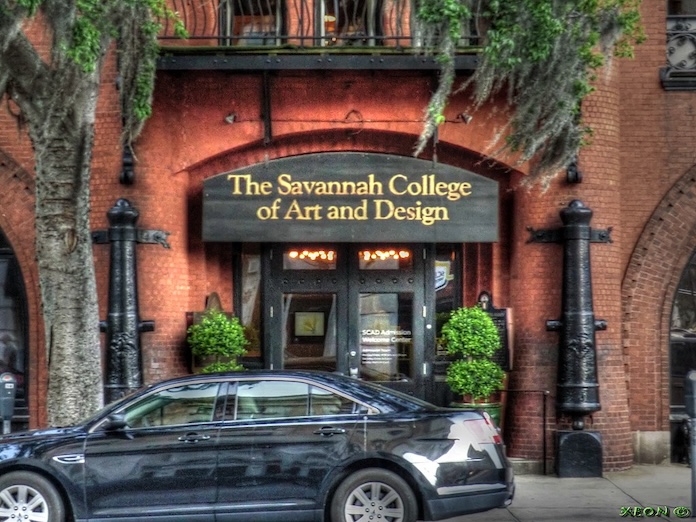
SCAD is recognized for its expansive curriculum, offering degrees in Animation, Sequential Art, Interactive Design, Film & Television, and more. With campuses in Savannah, Atlanta, and an outpost in a 16th century farmhouse in Lacoste, France, SCAD allows students to experience a range of cultural and artistic influences. A key feature of SCAD’s curriculum is the ability to complement a major with one of over 70 minors, promoting interdisciplinary learning.
Dr. Tina Brooks, TTA Senior Private Counselor who spent some time at SCAD recently, notes: SCAD is unlike any other college campus, with facilities in 80 buildings around Savannah. From a VR volume (where a game design engine creates Virtual Reality filming sets), to a massive backlot where students can add to their portfolios by participating in professional film shoots, to 3-D printers for any student to use, to an extensive resource library of fabric samples to prep for a fashion show of student work, the resources and inspiration are all a creative student could want.
Rhode Island School of Design (RISD)
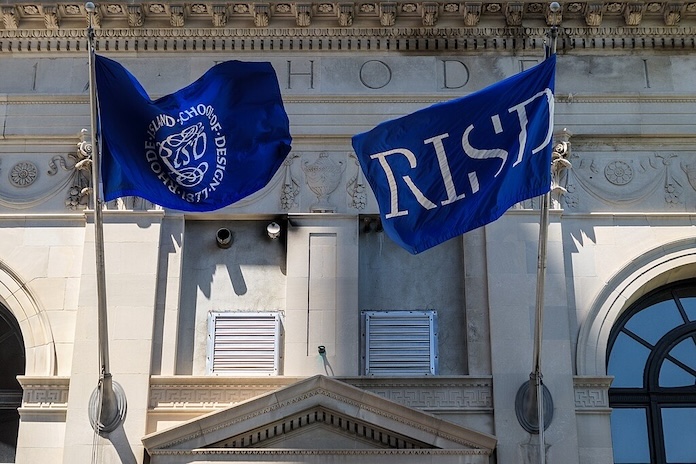
One of the most prestigious art and design schools in the world, RISD offers a Bachelor of Fine Arts (BFA) degree in various disciplines, including Painting, Graphic Design, Industrial Design, Illustration, and Architecture. RISD emphasizes a strong foundation in studio-based learning while also integrating liberal arts courses. Additionally, its proximity to Brown University allows students to take advantage of cross-registration opportunities, adding depth to their education.
School of the Art Institute of Chicago (SAIC)
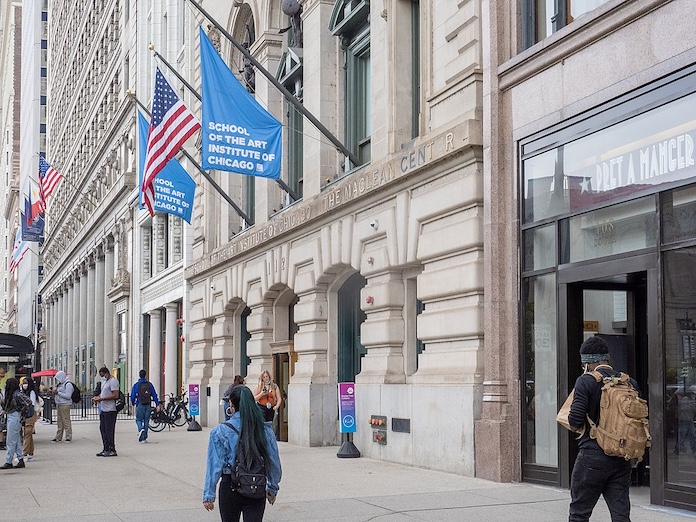
Connected to the world-renowned Art Institute of Chicago, SAIC provides students with an interdisciplinary approach to art education. Students can explore programs such as Art Therapy, Comics & Graphic Novels, Visual Communication Design, Fiber & Material Studies, and Sound Art. The curriculum at SAIC is largely self-directed, allowing students to carve their unique artistic paths with the support of faculty and extensive facilities.
Pratt Institute

Located in Brooklyn, New York, Pratt Institute offers specialized BFA programs in disciplines like Fashion Design, Photography, Digital Arts, and Interior Design. The school strongly advises against applying as an undecided major, emphasizing the importance of early research into its diverse programs. Beyond studio courses, Pratt integrates liberal arts and humanities courses to foster critical thinking and contextual awareness in its artists and designers.
California Institute of the Arts (CalArts)
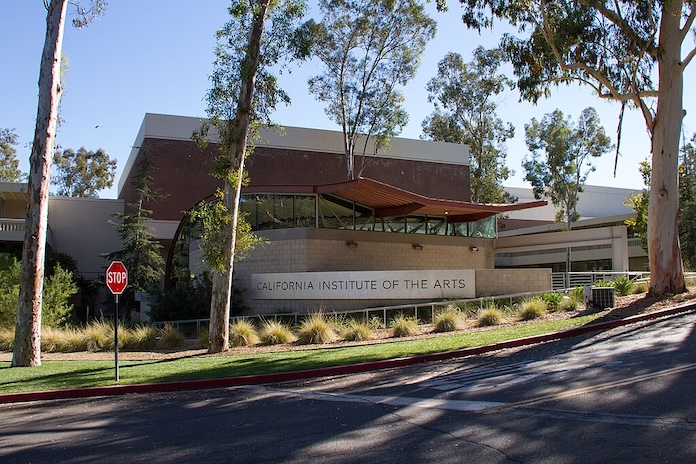
Co-founded by Walt Disney, CalArts is famous for fostering creativity and innovation in the arts. The BFA programs span Animation, Experimental Film, Character Animation, and Fine Arts, among others. With a focus on experimental and avant-garde approaches, CalArts encourages students to push boundaries in their creative practice. The institute’s close ties to the film and animation industry make it an excellent choice for students looking to work in entertainment and media.
COLLEGES WITH STRONG UNDERGRADUATE ART PROGRAMS
While primarily known for their strengths in other fields, the following universities also offer top-tier undergraduate art programs with excellent faculty and resources:
New York University (NYU)
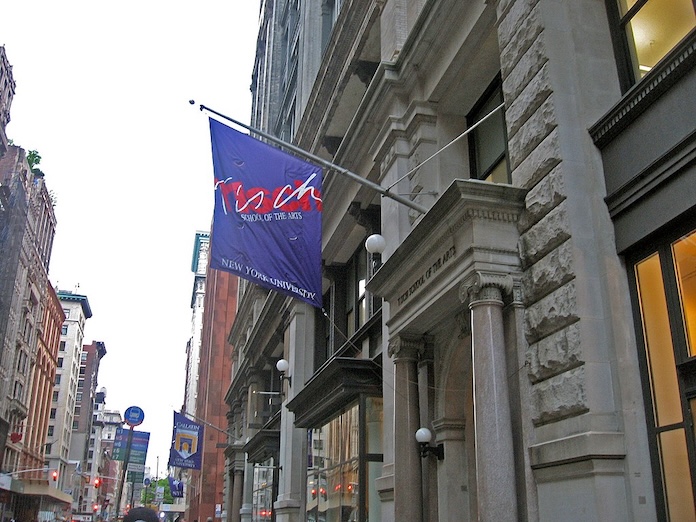
NYU’s Tisch School of the Arts and the Steinhardt School offer programs in Fine Arts, Studio Art, and Digital Art. The integration of NYU’s extensive liberal arts curriculum with hands-on studio work makes it an appealing choice for students seeking a well-rounded education in the city that never sleeps.
Massachusetts Institute of Technology (MIT)
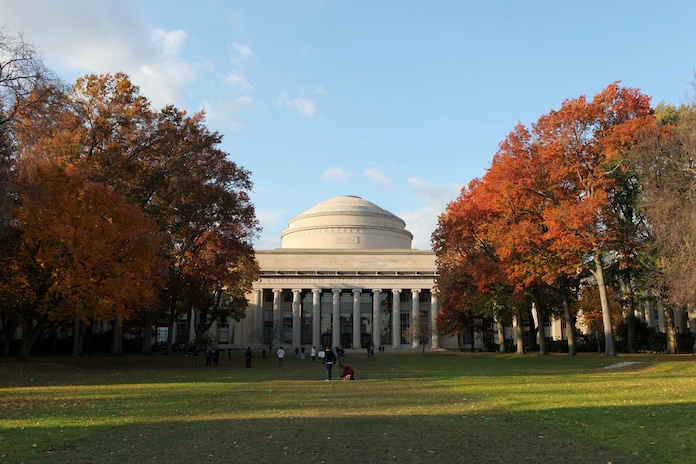
MIT’s Arts, Culture, and Technology (ACT) program provides an interdisciplinary approach to art-making, often merging technology with creative expression. With resources such as the MIT Media Lab, students have access to cutting-edge research in interactive design, computational art, and digital fabrication.
Yale University
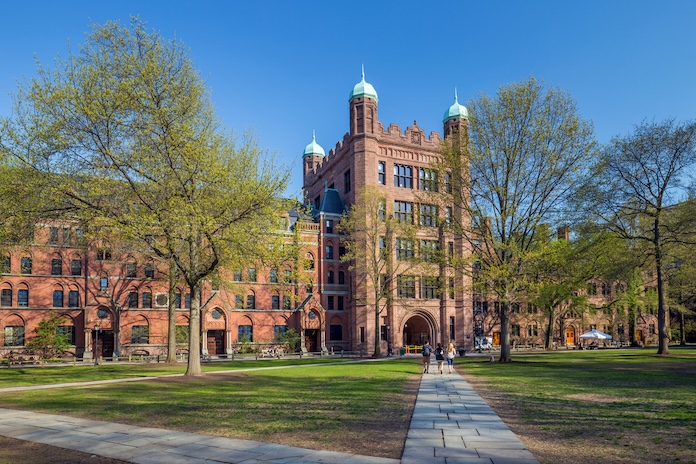
Yale’s School of Art offers rigorous undergraduate courses with a strong emphasis on conceptual development and critical discourse. While the only degree offered is the MFA, the undergraduate program provides a strong foundation in Painting, Sculpture, Graphic Design, and Printmaking.
Carnegie Mellon University
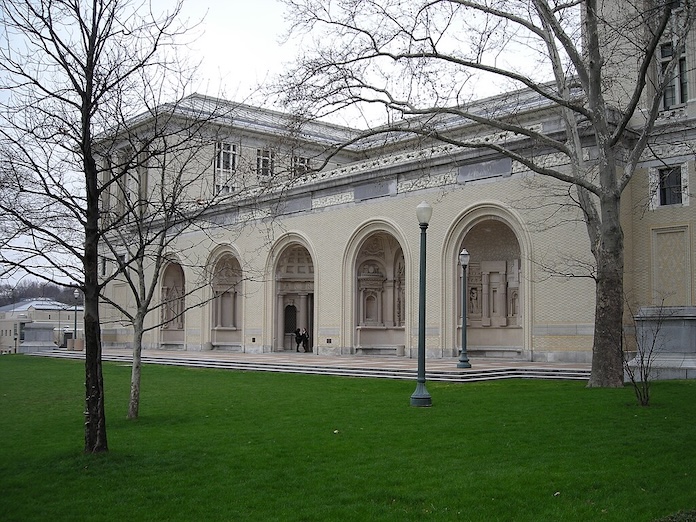
The School of Art at Carnegie Mellon University offers a Bachelor of Fine Arts with an emphasis on interdisciplinary practice, incorporating new media, robotics, and computational art. The program’s connection to CMU’s strong technology and engineering departments makes it ideal for students interested in digital and interactive media.
University of California, Los Angeles (UCLA)
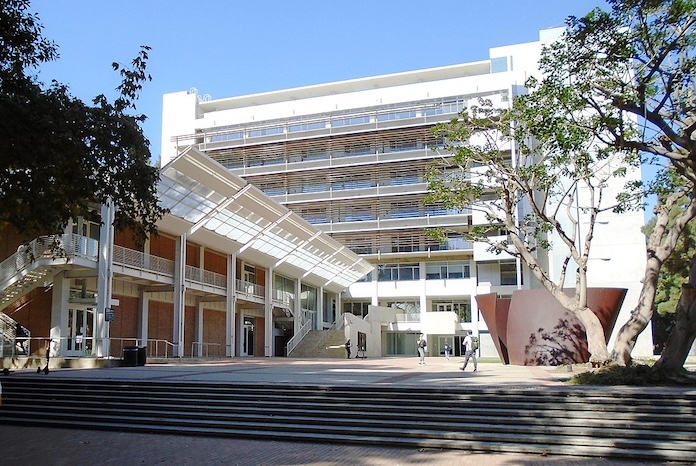
UCLA’s School of the Arts and Architecture offers a competitive undergraduate art program with access to state-of-the-art studios and research opportunities. Areas of study include Painting & Drawing, Ceramics, Sculpture, and New Genres, encouraging experimental and multimedia approaches.
Princeton University
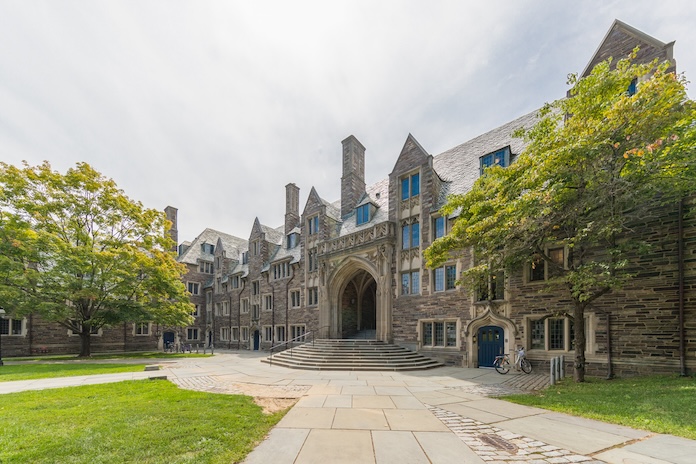
Though better known for its liberal arts and sciences programs, Princeton offers a highly selective Visual Arts program within the Lewis Center for the Arts. The program provides intimate studio courses and one-on-one faculty mentorship, allowing students to develop a deeply personal and reflective artistic practice and offers the Princeton community over 100 performances, exhibitions, readings, film screenings and lectures each year.
By conducting early research, attending summer programs, and thoughtfully preparing portfolios, aspiring art students can identify and apply to the programs that best fit their creative ambitions. These schools offer a diverse range of opportunities, from traditional fine arts to cutting-edge digital media, ensuring that every student can find a place where their artistic vision will thrive.
If you enjoyed this post, follow us on Instagram @toptieradmissions for more tips and subscribe to our blog for expert insights & college admissions news!
The post Top Art Schools appeared first on Top Tier Admissions.
Emory Acceptance Rate: Early Trends 21 Mar 3:30 AM (14 days ago)
Emory University, a research university affiliated with the United Methodist Church in Atlanta, Georgia, accepted 995 individuals under its binding Early Decision I policy. Emory admitted 805 to the Atlanta campus and 400 to its Oxford College, with 210 of these students admitted to both campuses.
EMORY ACCEPTANCE RATE: EARLY
Emory’s overall early acceptance rate was 31%. The university received a record-breaking total of 3,311 applications — a 21% increase from the previous year, according to The Emory Wheel.
“This year’s applicant pool is certainly the strongest and most competitive that I have experienced in Early Decision I during my 12 years at Emory University,” said Mark Butt, director of admissions at Emory.
64 students were also matched with Emory’s Class of 2029 through the QuestBridge program.
Last year, Emory accepted 5,508 of the 34,914 Class of 2028 applicants for an overall acceptance rate of 14%.

College Private Counseling
Develop an organized and effective application strategy that leverages your academic and extracurricular experience to stand out.
TTA TOP TIP: Before applying to Emory University, spend time researching its undergraduate programs — especially the differences between its two campuses. While applicants can choose to apply to either or both campuses, it’s critical to have compelling reasons for your choices. Starting at the Oxford campus offers students a more intimate, liberal arts environment, as there are no upperclassmen on this campus. Underclassmen at the Emory campus, on the other hand, co-exist in a larger urban setting with both upperclassmen and graduate students.

Application Boot Camp®
Need strategic guidance from start to finish? Try Application Boot Camp®.
At Top Tier Admissions, we are committed to making the college admissions process more transparent. Easy access to clear data helps families understand trends in college admissions to make more informed decisions. This year we’re once again collecting early acceptance rate data at selective schools and providing insight and analysis of our own.
WANT TO READ MORE?
Are you thinking about applying to Emory? Curious about admissions trends and strategies to improve your odds? Contact us to discuss our Application Boot Camp® or Private Counseling program— we look forward to supporting you!
- Emory University Admissions
- Emory University: Early Acceptance Rate (Class of 2028)
- Emory Acceptance Rate: How to Get into Emory (Class of 2027)
- Average GPA and Class Rank at Top Colleges
- Early Application Insights and Predictions: Class of 2029
- Regular Decision Notification Dates: Class of 2029
If you enjoyed this post, follow us on Instagram @toptieradmissions for more tips and subscribe to our blog for expert insights & college admissions news!
The post Emory Acceptance Rate: Early Trends appeared first on Top Tier Admissions.
Key Relationships That Can Make or Break Your College Application 20 Mar 6:31 AM (15 days ago)
When planning for the college application process, we often focus on the parts of the application you create: your essays, your extracurricular activities, your award-winning projects, etc. The reality, though, is that your complete college applications will also include the writing, insights, and feedback of many other people: your teachers, your high school counselor, your college interviewer, and perhaps even the regional admissions officer at your target school. It’s crucial that you build strong relationships with these potential admissions advocates, who can be a great source of help to you during the admissions process.
KEY RELATIONSHIPS THAT CAN MAKE OR BREAK YOUR COLLEGE APPLICATION
How can you foster those relationships? We’ve got you covered!
YOUR TEACHERS: In the spring of junior year, you will ask two teachers to write your letters of recommendation. We recommend choosing teachers in whose classes you have earned strong grades and who can speak highly of your classroom engagement. This means you’ll want to spend junior year being an excellent student — going above and beyond on your assignments, contributing productively and regularly to class discussions, collaborating with other students, and (when necessary) seeking and implementing feedback from your teacher. Some teachers will also ask you to fill out a “brag sheet” that allows you to provide details on your work in their class and highlight specific moments that showcase your strengths.
How should you ask for these letters of recommendation? We recommend checking first to see if your school has an established process for seeking recommendations. Some schools set aside particular days for students to ask teachers for letters, while others require students to make requests through their counselors. If your school has no established process, we suggest reaching out directly to your teacher — either by email or during a quiet moment before or after class — to ask them to write a recommendation for you. When making this request, make sure to explain why they are the perfect person to vouch for you (e.g., “I’m really proud of the work I have done in your class” or “I’m hoping to major in English, so having you write about my work as an English student would be really meaningful”) and offer to provide any materials that might be helpful to them (e.g., copies of papers or projects you produced in their class, your resume, etc.).
TTA Top Tip: Especially if you go to a big school, make sure to request recommendations early! Popular teachers are often unable to write letters for all of the students who request them, and many work on a first-come-first-served basis. Don’t delay and miss out on a great letter!
YOUR COUNSELOR: As we’ve noted before, your college application won’t just include letters from your teachers: it will also include a letter from your high school counselor. In contrast to your teachers, who will speak to your work as a student in their classroom, your counselor will highlight your role in the school community. They will also prepare a report that contextualizes your position in your class as a whole and rates you in the categories of academics, extracurriculars, and personal character.
As you might imagine, it is essential that you get to know your counselor so that they are eager to support you in the college admissions process. You also want to make sure they know about your plans and your contributions to the school community so that their letter will align with the way you present yourself to colleges. If you can, make sure to meet with your counselor early and often — you might start by seeking their feedback on colleges you should explore and then stop by again after you have done virtual or in-person tours of those schools to discuss your thoughts. You can also share your resume with them and, if they encourage it, set up times to review your college essays together.
Mock Interview & Analysis
Gain practical experience and valuable insights to excel in interviews.
YOUR ADMISSIONS INTERVIEWER: Many colleges (although not all) will offer applicants the opportunity to participate in an interview as part of the admissions process. These days, interviews can take many forms (informational or evaluative, in-person or virtual), but they generally require you to sit down one-on-one with an admissions officer or an alum of your target college.
In our previous interview guidance, we stressed the importance of researching your target college in advance of your interview, dressing in business casual attire, coming up with a clear elevator pitch to describe yourself, and asking insightful questions. A few other things you can do to build a good relationship with your interviewer:
- Look up your interviewer in advance: Is your interviewer a recent graduate who can bond with you about their memories of the college admissions process? An established professional doing work in your dream field? Looking up your interviewer in advance can give you a sense of how the conversation might go. Just don’t tell them that you Googled them beforehand!
- Ask them questions about themselves: Alumni interviewers, in particular, generally volunteer to interview prospective students because they loved their college experience. Ask them about it!
- Find points of commonality: Do you both love a particular author? Did you recently travel to a similar place? Many colleges will try to pair you with an alumni interviewer who has a background related to your stated major — take advantage of that to discuss your common interests!
The goal: your interviewer should leave your interview confident that you are the perfect student for their college and eager to help you get admitted there.
YOUR REGIONAL ADMISSIONS OFFICER: During the fall, before the admissions process begins in earnest, many admissions officers will travel to venues in their region to speak with students. They might participate in college fairs, regional admissions events, or even lead info sessions at individual high schools. Take advantage of these opportunities to show demonstrated interest and get facetime with the admissions officer who will likely be reviewing your application! If you are unable to attend a local event, we recommend emailing the admissions rep to introduce yourself and ask a question about their institution. In the past, we’ve seen such conversations transform into extensive email correspondences or even meetings for coffee.
It’s worth noting, however, that admissions officers from large, elite colleges generally have less time and incentive to build relationships with potential applicants than those from smaller or less selective schools. This isn’t to say you should ignore those admissions officers — just don’t be discouraged if your admissions rep has limited time to chat with you.

College Private Counseling
Develop an organized and effective application strategy that leverages your academic and extracurricular experience to stand out.
SAYING THANKS
It’s not enough to ask for help from these advocates — you also want to thank them for providing it! The best way to show your gratitude is through a thank you note, either handwritten or sent by email. When writing your thank you note, make sure to be specific about what the person did for you, how it helped you, and why you are grateful to them.
For example, after logging off from a virtual interview with an alum at your target college, you might write a message that goes something like:
Dear Ms. Smith,
Thank you so much for making time to meet with me today! It was such a pleasure to speak with you and to hear about your experiences at X University. I was so excited to learn from you about the university’s Creative Writing Fellow readings and poetry tutorials. As an aspiring poet, I could see myself embracing both opportunities, taking inspiration from the works of brilliant writers and then working with them directly to create my own poetry collection. I was also thrilled to hear about your own bonds with your English classmates — that reflects exactly the kind of close-knit community I am hoping to find at college.
Thank you again for all of your insights and guidance. They have made me more excited than ever about the prospect of spending my next four years at X University!
Sincerely,
Student Name
P.S. I’ll also be sure to check out Murakami’s newest novel — I’m thrilled to hear that it’s as engaging as Kafka on the Shore!
As you can see, this letter makes clear the specific things the student appreciated about their interview (the chance to learn more about creative writing programs at X University) and then references particular moments in the conversation that were meaningful to them. It also reminds the interviewer of instances where they bonded with the student over their shared love of writing and their enjoyment of Murakami’s novels. The letter is not long, but it is precise and complimentary — two key factors in every good thank you note!
The result of all of these efforts: strong relationships with people who are eager to support you in the college admissions process, paving the way to your dream school and providing valuable guidance to help you make the most of your amazing college opportunities!
Ready to cultivate your admissions advocates? Reach out to us today to learn more about how Top Tier Admissions can help guide you through this important journey.
If you enjoyed this post, follow us on Instagram @toptieradmissions for more tips and subscribe to our blog for expert insights & college admissions news!
The post Key Relationships That Can Make or Break Your College Application appeared first on Top Tier Admissions.
Grade Inflation and the Changing Landscape of College Admissions 18 Mar 5:52 AM (17 days ago)
In college admissions, the term “grade inflation” is frequently used. It refers to the trend of teachers awarding higher grades for the same level of work over time. As a result, grades become less meaningful, making it harder for colleges to determine what truly constitutes A-level work.
THE RISE OF THE HIGH SCHOOL GPA
Colleges can easily notice school-specific grade inflation by looking at the school’s yearly college profile. Many schools provide the colleges with a breakdown of GPAs or a grade distribution chart, like the ones below. In the first example, 73% of the graduating class at this school has over a 3.5 GPA, which translates to an A-/B+ average. In the second example, A grades (not even A-) are the most common grades given at the school in every subject.
Example 1:
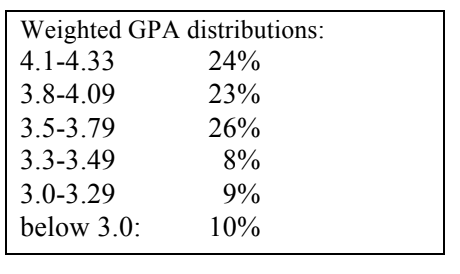
Example 2:
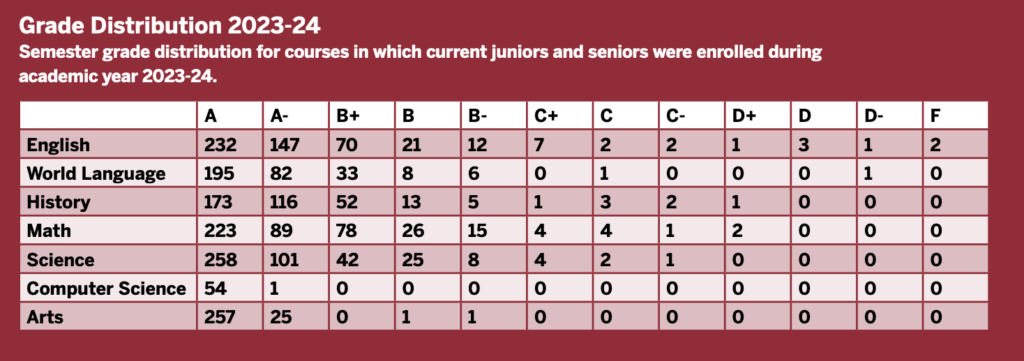
While grade inflation is seen in specific schools, it has also become a nationwide trend. In August 2023, ACT released their findings from a twelve year study (2010-2022), concluding that average grades for U.S. students had risen in every subject, and most notably, in math. This occurred even though ACT subject tests remained relatively stagnant. In fact, ACT scores even dropped a bit in some areas. The tables below show this phenomenon.
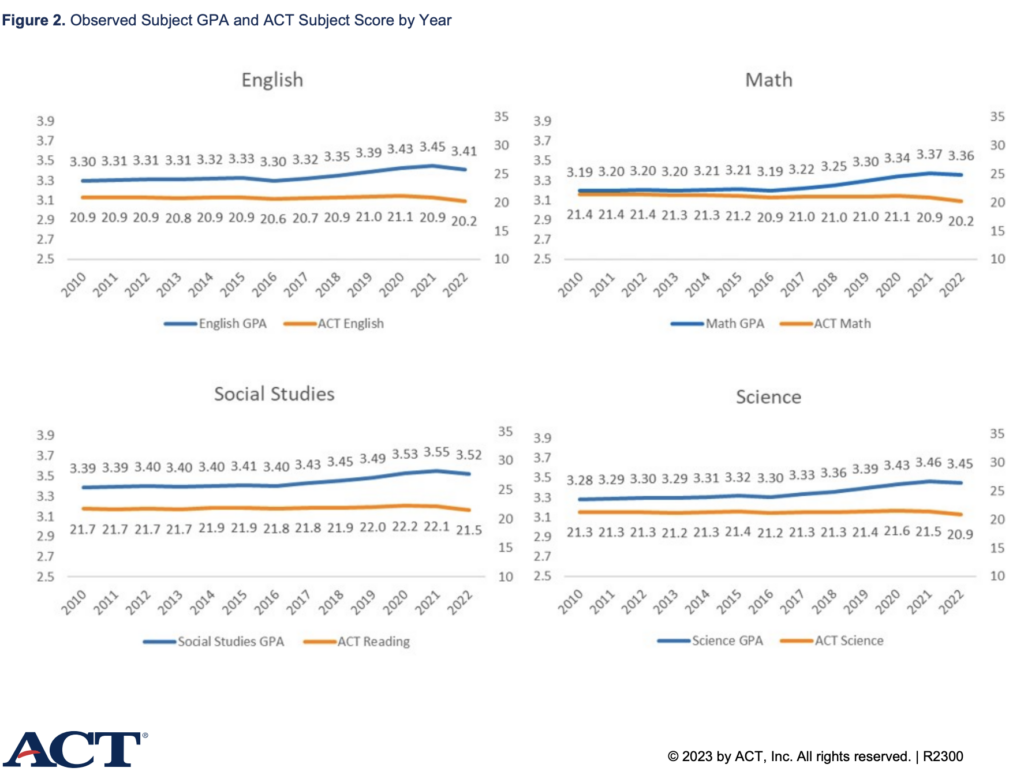
CAUSES OF GRADE INFLATION
While there is no definitive study on the causes of grade inflation, several cultural changes around school achievement can be considered. External pressures from rankings such as Niche and U.S News & World Report, and nearly every local paper consistently rank high schools. Yes, they use testing, but not every student takes the SAT or ACT in the recent test optional landscape, so graduation rates and sometimes GPA is also included. If funding is attached to these rankings, there is even more impetus for a school administration to encourage raising GPAs.
Additionally, as highly selective colleges become even more competitive, there is pressure from students and parents to raise grades. High-performing students seek perfect GPAs, and teachers are under more pressure to offer retakes, extra credit, and flexible deadlines, which lowers student accountability.
GRADE INFLATION: HOW COLLEGES ARE RESPONDING
As evidenced by the school profiles listed at the top of this post, colleges are aware of rampant grade inflation both in individual schools and across the country. With GPAs telling colleges less information about a student’s ability than they used to, colleges have begun to focus on other measures of achievement to supplement the GPA. For example, universities, especially those who are highly selective, will take a close look at the rigor of a student’s courseload. Is the student taking the most challenging curriculum at their school (IB, AP, Honors, Dual Enrollment, etc.) and receiving all As or are they taking an average courseload with the same grade results. Because of the increasing selectivity among the top schools in the country, it is no longer acceptable just to achieve all As. A student must also be enrolled in a challenging curriculum across all subjects.
In recent years, many of the most selective colleges have returned to relying on standardized testing. After the mass exodus from testing due to lack of access during the pandemic, colleges like MIT, Georgetown, Brown, Cornell, Harvard, and Dartmouth, among others, have reinstated the requirement for SAT or ACT testing, arguing that testing is a more consistent predictor of college success that helps admissions offices evaluate an applicant in context.

AP Exam Tutoring
Our tutors offer customized tutoring designed to fit the needs of each student.
Similarly, AP exam scores have gained importance as a standardized measure of academic ability. Unlike GPAs, which vary widely across schools, AP scores provide colleges with a uniform benchmark to assess students’ mastery of college-level material. High scores on AP exams demonstrate not only subject proficiency but also the ability to handle rigorous coursework, reinforcing a student’s academic strengths. As a result, students aiming for top-tier schools are increasingly prioritizing strong AP exam performances to differentiate themselves in an applicant pool where inflated grades are common.
Finally, highly selective colleges have reiterated the value of a holistic review. This review goes beyond just GPA and test scores, considering essays, extra-curricular activities, and letters of recommendation, among other things, as admissions offices consider a student’s candidacy. GPA is only one factor in the selection process, and even a high GPA can be outweighed by weaker performance in other areas.
HOW STUDENTS CAN STAND OUT
As grade inflation continues to shape high school academics, students need to focus on genuine learning, course rigor, standardized test scores, and outside achievements. Colleges now expect high classroom performance. They want students who challenge themselves and contribute meaningfully to their communities. Students should concentrate on enrolling in the most challenging courses available, achieving high scores on standardized tests (including APs, when possible), excelling academically to secure strong letters of recommendation, and cultivating a compelling portfolio of extracurriculars, leadership roles, and authentic accomplishments.
If you enjoyed this post, follow us on Instagram @toptieradmissions for more tips and subscribe to our blog for expert insights & college admissions news!
The post Grade Inflation and the Changing Landscape of College Admissions appeared first on Top Tier Admissions.
Georgetown Acceptance Rate: Early Trends 14 Mar 11:50 AM (20 days ago)
Georgetown University, a prestigious private university in Washington D.C., is the oldest Jesuit university in the United States.
Georgetown’s Early Action (EA) policy stands out in a few key ways. First, all applicants who are not accepted during the Early Action round are deferred to the Regular Decision pool for further review. Second, Georgetown’s EA policy is restrictive, meaning that students applying through this round are prohibited from applying to any binding Early Decision schools. However, students are still permitted to apply to other schools with Early Action or Regular Decision admissions plans. There is also not a significant statistical advantage in applying early, as the acceptance rate is usually quite similar. Typically, about 15% of the deferred candidates end up being admitted in the spring, according to the university.
GEORGETOWN ACCEPTANCE RATE: EARLY TRENDS
Georgetown admitted 917 out of 8,254 early applicants to its Class of 2029. The acceptance rate for Georgetown’s early action program this year was 11%, up from 10.3% the previous year, according to The Hoya.
Georgetown’s McDonough School of Business had the lowest acceptance rate at 9.11%. The College of Arts & Sciences had an acceptance rate of 10.92%, while the School of Foreign Service’s was 11.61%. The School of Health admitted 81 out of 537 applicants for an acceptance rate of 15.08% and the School of Nursing admitted 32 out of 194 applicants for an acceptance rate of 16.49%.
In recent years, Georgetown has come under fire for continuing to favor legacy students in the admissions process. The D.C. State Board of Education is currently considering a bill to end legacy and donor preferential admissions for private universities in the area, mainly due to Georgetown student advocacy.

Application Boot Camp®
Need strategic guidance from start to finish? Try Application Boot Camp®.
TTA TOP TIP: Out of the top 50 private universities in the United States, MIT and Georgetown are the only two that cannot be applied to through the Common App. Thankfully we have a handy guide for Navigating the Georgetown Application. Georgetown applicants are also required to participate in alumni interviews, a practice that is decreasingly common at other similar universities. These interviews can provide candidates with a valuable opportunity to showcase their interest in the university.
At Top Tier Admissions, we are committed to making the college admissions process more transparent. Easy access to clear data helps families understand trends in college admissions to make more informed decisions. This year we’re once again collecting early acceptance rate data at selective schools and providing insight and analysis of our own.
WANT TO READ MORE?
Are you thinking about applying to Georgetown? Curious about admissions trends and strategies to improve your odds? Contact us to discuss our Application Boot Camp® or Private Counseling program— we look forward to supporting you!
- Navigating the Georgetown Application
- Get into Georgetown
- Georgetown’s Supplemental Essay Prompts
- Average GPA and Class Rank at Top Colleges
- Early Application Insights and Predictions: Class of 2029
- What are the Best Jesuit Schools?
If you enjoyed this post, follow us on Instagram @toptieradmissions for more tips and subscribe to our blog for expert insights & college admissions news!
The post Georgetown Acceptance Rate: Early Trends appeared first on Top Tier Admissions.